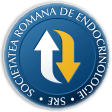
- Login
- Register
- Home/Current Issue
- About the journal
- Editorial board
- Online submission
- Instructions for authors
- Subscriptions
- Foundation Acta Endocrinologica
- Archive
- Contact
 Romanian Academy
Romanian Academy
 The Publishing House of the Romanian Academy
The Publishing House of the Romanian Academy

ACTA ENDOCRINOLOGICA (BUC)
The International Journal of Romanian Society of Endocrinology / Registered in 1938in Web of Science Master Journal List
Acta Endocrinologica(Bucharest) is live in PubMed Central
Journal Impact Factor - click here.

-
Actualities in medicine
Dobrescu R, Badiu C
An Expanding Class in the Treatment of Thyroid Cancer: Tyrosine Kinase InhibitorsActa Endo (Buc) 2015 11(4): 536-539 doi: 10.4183/aeb.2015.536
AbstractThyroid cancer, the most frequent endocrine malignancy, is in most patients a treatable disease, with excellent outcome and cure rate. However, a few patients present with rapidly progressive metastatic differentiated thyroid cancer which loses the radioiodine uptake capacity. These rare cases are prone to a rapid evolution and poor prognosis. Medullary thyroid cancer is a neuroendocrine tumor occurring sporadically or as part of endocrine tumor syndromes, genetic tests being part of standard clinical evaluation. Current knowledge of tumor biology in thyroid cancer allowed development of a new class of drugs, thyrosine kinase inhibitors (TKI). Their use in clinical trials allowed the development of more specific drugs, increasingly effective and with less adverse reactions, interfering with multiple thyrosine kinase enzymes. Improvement of the progression free survival, decrease of tumor volume and tumor markers, as well as patients with stable disease on TKI are strong arguments for including patients in clinical trials. Currently, only four TKI are approved by FDA: sorafenib and lenvatinib for DTC; vandetanib and cabozantinib for MTC. In this paper we present this new class of drugs used in the treatment of aggressive thyroid cancer. -
Images in Endocrinology
Lider S, Gheorghiu M, Milos I, Badiu C
Malignant Paraganglioma Non-Responsive to MIBGIn MEN2A SyndromeActa Endo (Buc) 2022 18(4): 536-537 doi: 10.4183/aeb.2022.536
Abstract- -
Images in Endocrinology
Gheorghisan-Galateanu AA, Terzea D, Ioachim D, Carsote M
Not Just Hashimoto’s ThyroiditisActa Endo (Buc) 2019 15(4): 537-538 doi: 10.4183/aeb.2019.537
Abstract- -
Perspectives
Prada GI
Immunosenescence and Inflamm-AgeingActa Endo (Buc) 2014 10(4): 537-544 doi: 10.4183/aeb.2014.537
AbstractResearches on ageing phenomenon offer significant information regarding the consequences of stressors on immune system that affects longevity in the elderly. Immunosenescence has become the most common immunodeficiency state in humans, occurring in over 30% of community - dwelling elderly, and greater than 90% of elderly who are ill, taking medication, or residing in longterm care facilities. Immunosenescence may reflect tandem changes in neuroendocrine responses. There are several agingrelated changes in cortisol, DHEA and catecholamines, which are considered to set up a “vicious cycle of endocrinosenescence and immuno-senescence”. The low-level, chronic increase in innate, inflammatory response observed in older adults ultimately results in tissue damage and disease; the key inflammatory mediators in this process are CRP, nuclear factor (NF)-kB, IL-1-beta, IL-6, TNF-alpha, cyclooxygenase-2 (COX-2), and inducible nitric oxide (NO) synthase. Further, glucocorticoid inhibition of IL-6 production was observed to be lower in older compared to younger men following psychological stress. There are individual differences that protect aged people from stressors and strains, and it will be important to identify biological mechanisms of protection and those at risk who might benefit from early behavioral interventions. -
Case Report
Gupta R, Sharma A, Ksh A, Khadgawat R, Dinda AK
Phospathuric mesenchymal tumor of the sinonasal tractActa Endo (Buc) 2009 5(4): 537-542 doi: 10.4183/aeb.2009.537
AbstractBackground. Phosphaturic mesenchymal tumor (PMT) is a recently described concept\r\nunifying the mesenchymal tumor associated with oncogenic osteomalacia. Most of the cases of\r\nPMT occur in the extremities and appendicular skeleton. PMT occurring in the paranasal\r\nsinuses is extremely rare with only a few cases reported in the available literature.\r\nCase. A 51-year-old man presented with a long history of bone pains. Biochemical\r\nand radiologic investigations, including skeletal survey showed features of osteomalacia.\r\nPositron emission tomography (PET) scan showed a small tumor in the left nasal cavity,\r\nethmoid and sphenoid sinuses. Histopathological examination of the excised tumor showed\r\nfeatures of a phosphaturic mesenchymal tumor- mixed connective tissue variant. Excision\r\nof the tumor was associated with marked improvement in the biochemical parameters and\r\nremarkable clinical relief.\r\nConclusion. Phosphaturic mesenchymal tumor is a rare cause of osteomalacia and is\r\nusually associated with small tumors, which escape detection for long periods. Its occurrence in\r\nthe paranasal sinuses needs to be kept in mind and evaluated to allow for timely detection of the\r\ntumor with subsequent surgical excision and clinico-biochemical relief. -
Case Series
Nguyen K, Chen X, Hughes T, Hofflich H, Woods GN, McCowen KC
Surprisingly Few Women with Severe Osteoporosis by Bone Densitometry Undergo Workup for Secondary Causes - a Retrospective EvaluationActa Endo (Buc) 2021 17(4): 537-542 doi: 10.4183/aeb.2021.537
AbstractWe describe clinical features of women with extremely low bone density, and investigate secondary causes of osteoporosis. Our hypothesis was that this population would be enriched in identifiable causes of osteoporosis. We performed a retrospective review of medical records of all women seen at our university over 4 years with T-score on bone densitometry at/below -4 at any site. Historical and fracture details were abstracted. We considered a thorough work up to include Vitamin D, PTH, CBC, chemistry panel, cortisol, transglutaminase, myeloma screen, tryptase and 24-hour urine calcium. Results. 137 women were identified with T-score at/below -4. Percent identified as Asian was 26% (higher than local prevalence of 8%). Average BMI was 21.6 kg/ m2. Clearly identifiable causes of osteoporosis were noted in 57% (inflammatory disorder, glucocorticoid or antacid exposure, prolonged immobilization and alcoholism were most prevalent). Of the remainder, full work up was performed only in 8%. Endocrine consultation and white race predicted thoroughness of secondary work-up. Conclusion. Fragility fractures, leanness and Asian race were common in women with very low T-score. However, few new causes were identified. Underlying etiology was either immediately evident or inadequately studied, especially in minorities. -
Case Series
Bilici ME, Siklar Z, Unal E, Tacyildiz N, Aycan Z, Ozsu E, Uyanik R, Ceran A, Berberoglu M
The Use of Oral Bisphosphonates in Refractory Severe Hypercalcemia after Denosumab CessationActa Endo (Buc) 2024 20(4): 538-541 doi: 10.4183/aeb.2024.538
AbstractDenosumab,a monoclonal IgG2 antibody, is used as neoadjuvant therapy for giant cell bone tumors, particularly in inoperable or metastatic cases. It targets the receptor activator of nuclear factor kappa-β ligand (RANKL), which is overexpressed in tumor stromal cells. However, denosumab treatment can lead to side effects such as hypocalcemia during treatment and rarely but malignant hypercalcemia after discontinuation. The unpredictable onset time and persistent course of hypercalcemia attacks increase the duration of hospitalization and the risk of complications. Case. A 9-year-old girl with a giant cell bone tumor was treated with denosumab for diffuse tumor recurrence. Severe hypercalcemia occurred four months after completing therapy. Evaluation suggested "rebound-linked" hypercalcemia following denosumab discontinuation. IV bisphosphonate treatment normalized calcium levels initially, but hypercalcemia recurred, requiring repeated IV bisphosphonate administration. Oral alendronate was used weekly to prevent further attacks, resulting in stable calcium levels during follow-up. Results. Rebound hypercalcemia, as an unpredictable recurrent episode at any time, is a potential complication of denosumab cessation, and requires close monitoring post-treatment. Children may be at higher risk due to their rapid bone cycle. In long-term follow-up, IV and oral bisphosphonates can be used effectively in the management of especially life-threatening recurrent attacks. -
Notes & Comments
Hekimsoy Z, Eniseler EB, Erdem N, Ozdemir N
Catamenial Diabetic KetoacidosisActa Endo (Buc) 2022 18(4): 538-540 doi: 10.4183/aeb.2022.538
AbstractDiabetic ketoacidosis (DKA) is a common medical emergency situation. In rare cases, glycemic changes associated with the menstrual cycle may create a predisposing factor for DKA. In the absence of facilitating factors that may cause DKA, catamenial DKA should be considered. In the patients with catamenial DKA, increasing the insulin dose 1-2 days before menstruation may prevent the development of hyperglycemia or DKA associated with menstrual cycle. In this study, we present a 21-year-old female with type 1 diabetes mellitus (DM) that recurrently applied to our hospital due to DKA a few days prior to menstrual bleeding. -
Book Review
Badiu C
Health Equity in EndocrinologyActa Endo (Buc) 2023 19(4): 538-538 doi: 10.4183/aeb.2023.538
Abstract- -
Notes & Comments
Altun Tuzcu S, Cetin FA, Pekkolay Z, Tuzcu AK
18f-Fluorodeoxyglucose PET/CT Can Be an Alternative Method to Assessment of Insulin ResistanceActa Endo (Buc) 2019 15(4): 539-543 doi: 10.4183/aeb.2019.539
AbstractBackground. Insulin resistance is routinely measured by homeostasis model assessment of insulin resistance (HOMA-IR).Positron emission tomography of 18F-fluorodeoxyglucose combined with computed tomography (18F-FDG PET/CT) is a valuable assessment tool for patients with cancer or staging tumors. 18F-FDG PET/CT imaging can also be utilised to detect the metabolic activity of glucose in the adipose tissue, liver and muscles. The aim of this study was to determine insulin sensitivity in the liver, muscle visceral adipose and subcutaneous adipose tissue separately via18F-FDG PET/CT. Materials and method. Sixty three adult patients who underwent whole body 18F-FDG PET/CT scanning for clinical purposes (diagnosis or staging of cancer) between July and August of 2016 were included in the study. Patients were divided into two groups according to their BMI (Group 1: BMI<25kg/m2, Group 2: BMI>25kg/ m2). HOMA-IR,fasting glucose,insulin, triglycerides, total cholesterol, HDL levels were measured. We calculated SUV as the tissue activity of the ROI (MBq/g)/(injected dose [MBq]/ body weight [g]) on PET images and measured the maximum SUVs (SUVmax) of visceral adipose tissue (VAT) and subcutaneous adipose tissue (SAT),liver and rectus muscle ROIs (2 cm). SUV corrected by blood glucose level (SUVgluc) was calculated as SUVmax×blood glucose level/100. Student-t test, Chi-square test and Pearson correlation test were used for statistical analysis. Results. Mean glucose,insulin,HOMA-IR levels of the group-2 were statistically higher than of group-1. Muscle SUVmax and liver SUVmax of group-1 were statistically higher than of group-2. Muscle SUVgluc of group-1 was statistically higher than of group-2. HOMA-IR was negatively correlated with both SUVmax(r=-0.340, p=0.01) and muscle SUVmax(r=-0.373, p=0.005) Conclusion. 18F-FDG PET/CT has shown that the muscle tissue maximum FDG uptake was lower in the insulin resistance group. Therefore, 18-FDG PET/CT could be a valuable tool for diagnosing insulin resistance.